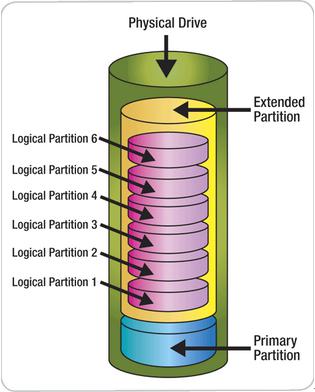What is logical partition? This article will offer a brief introduction to logical partition, like its capacity and classification.
Logical partition is a contiguous area on the hard disk. The difference is that a primary partition can only be divided into a drive, and each primary partition has a separate boot block. The hard disk can support up to 4 primary partitions, while an extended partition can be divided into multiple logical drives which cannot host a separate operating system. Primary and extended partitions are DOS partitions.
When you get a new hard drive, you need to partition it before you format and use it. In this situation, a partition manager can help you do this job easily – you can use MiniTool Partition Wizard.
Classification
A hard drive must have one primary partition, but it supports up to 4 primary partitions. Besides, it can have one extended partition at most. In other words, it can support 3 primary partitions and one extended partition with multiple logical drives.
The active primary partition is the boot partition. It is always the first partition (C drive) on the hard disk. Read this previous post to learn the way to set active partition: How to Set Partition as Active or Inactive
After dividing primary partition, users can divide the remaining space into an extended partition. Of course, users can divide some remaining space into extended partition. But, this way will waste some free space.
However, the extended partition can’t be directly used, and it should be divided into several logical partitions where data can be saved.
Capacity
Primary partition can also become a “ boot partition ”, which will be considered as the first partition on the hard disk by operating system and motherboard. Therefore, the C drive is always located in the first place of the hard disk.
MBR hard disk supports up to 4 primary partitions. If users need more partitions, they need an extended partition record ( EBR ) which is stored on extended partition. So well, users can divide the extended partition into multiple logical drives.
The Application of Logical Partition on MBR
Since MBR disk supports up to 4 primary partitions, the extended partition is widely used to meet users’ needs because an extended partition can be divided into multiple logical drives.
The boot record of logical drive is chained. Each logical partition has an extended boot record (EBR) which is similar to the MBR structure.
By default, Windows operating system only separates a primary partition to store system, and divides the remaining space into extended partition.
Linux operating system will name the partition from sda1 to sda4 or from hda1 to hda4. ( Note: the letter “a” represents the number of hard disk For MBR disk, numbers 1-4 belong to primary partitions ( or extended partition ), and the number of logical partition starts from 5.)
The size of a single partition in MBR disk can amount to 2TB. Therefore, if users want to use disk over 2TB, they need to convert the MBR disk to GPT.
